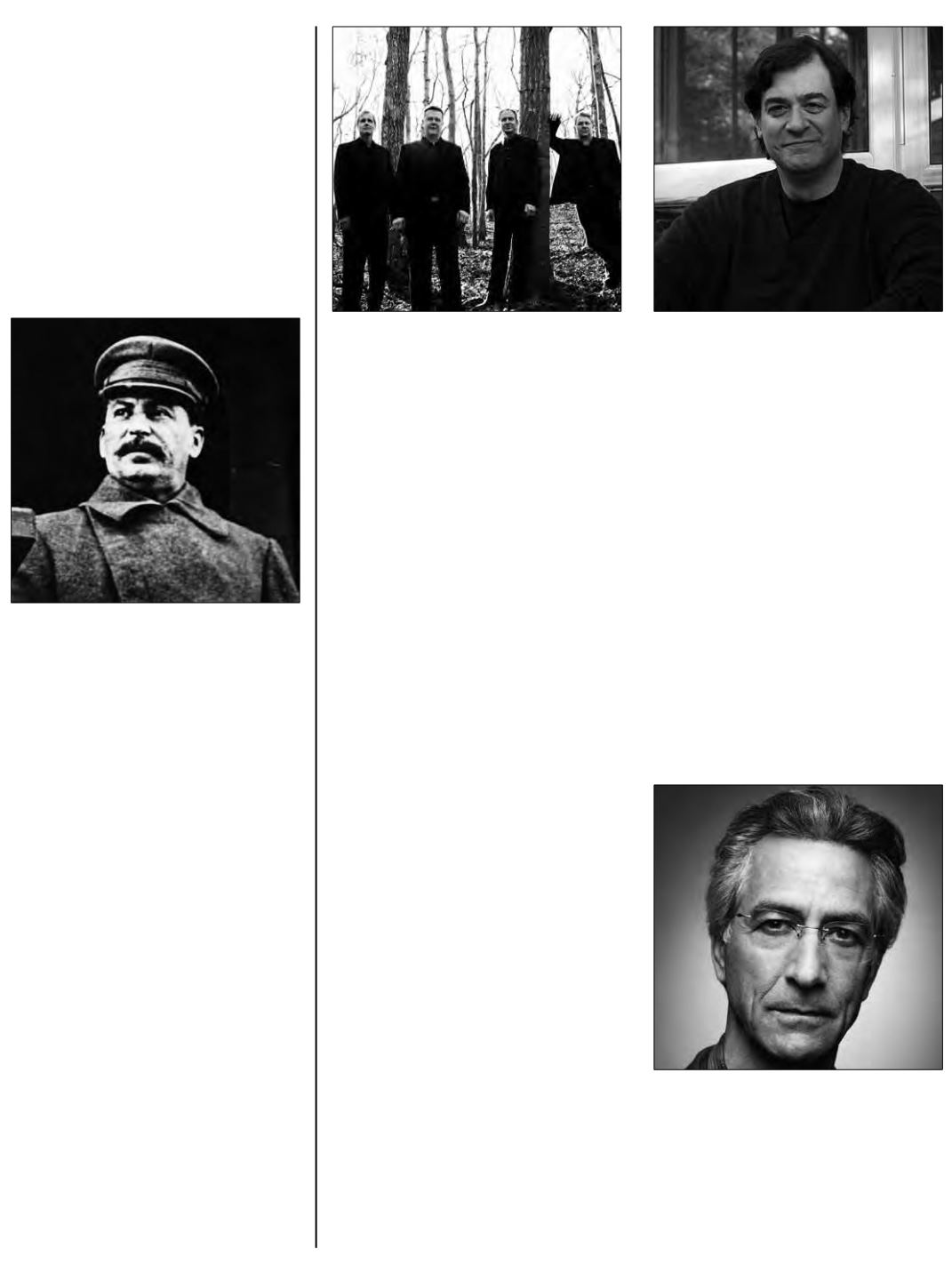

EMERSON STRING QUARTET
Formed in 1976, the Emerson String Quar-
tet took its name from the American poet and
philosopher Ralph Waldo Emerson. Violinists
Eugene Drucker and Philip Setzer alternate in
the first-chair position and are joined by violist
Lawrence Dutton and cellist Paul Watkins, who
in 2013 became the quartet’s first new member
since 1979. The ESQ was the first chamber en-
semble to be awarded the Avery Fisher Prize in
2004, was named
Musical America
’s Ensemble
of the Year in 2000, and has been given hon-
orary doctorates by Middlebury, Wooster, and
Bard Colleges, as well as the University of Hart-
ford. Since 2002 the ensemble has been quar-
tet-in-residence at Stony Brook University and
is in its 39th season of residence at the Smith-
sonian Institution. During its years recording
for Deutsche Grammophon, the ESQ won nine
Grammy and three
Gramophone
Awards for
albums that included the complete quartets by
Bartók, Beethoven, Shostakovich, and Mendels-
sohn, as well as chamber works by Janáček and
Martinů; quartets by Grieg, Nielsen, and Sibel-
ius; and Mendelssohn’s Octet. Other notable re-
cordings include Schubert’s String Quintet with
cellist Mstislav Rostropovich, Schumann’s Piano
Quintet and Quartet with Menahem Pressler,
Webern’s complete string works, Barber’s
Do-
ver Beach
with baritone Thomas Hampson, and
quartets by Schumann, Brahms, Dvořák, Smet-
ana, Tchaikovsky, Borodin, and Prokofiev, many
of which received award nominations. The quar-
tet’s latest album—the first release by Universal’s
new US classical label, Decca Gold—entirely
features works never before recorded by the
ensemble: Britten’s String Quartets Nos. 2 and
3 and a selection of chaconnes and fantasies by
Purcell. Earlier this year, the ESQ toured the US
and Europe with pianist Evgeny Kissin, and in
2015 it was honored with the Richard J. Bogo-
molny National Service Award from Chamber
Music America. The Emerson String Quartet
made its Ravinia debut in 1985 and returns to-
night for its 24th season.
JAMES GLOSSMAN
James Glossman has directed well over 200
plays for professional theaters and educational
programs across the United States, spanning
works by William Shakespeare, George Ber-
nard Shaw, Arthur Miller, David Mamet, Sam-
uel Beckett, Sam Shepard, Harold Pinter, Tom
Stoppard, Brian Friel, Athol Fugard, Stephen
Sondheim, August Wilson, Oscar Wilde, and
Thornton Wilder, among others, as well as new
plays by emerging and established playwrights.
His productions of
Bluff
with John Astin have
been seen across the United States, and his stag-
ing of
The Value of Names
, starring Jack Klug-
man as a once-blacklisted actor, played in New
York, New Jersey, and Los Angeles. His adapta-
tion of Raymond Chandler’s noir classic
Trouble
Is My Business
received its world premiere in
a sold-out run at Portland Stage, following an
earlier benefit staging with David Strathairn at
Shadowland Stages in Ellenville, NY, of which
he is associate director. He recently directed the
first production in 50 years of Sheldon Harnick’s
“lost” musical comedy
Smiling, the Boy Fell Dead
with a cast led by Judy Kaye and Tony Roberts.
DAVID STRATHAIRN
David Strathairn is perhaps best known for his
work in John Sayles’s films
Eight Men Out
,
Mat-
ewan
,
Limbo
, and
City of Hope
, among others,
and for his portrayal of Edward R. Morrow in
George Clooney’s film
Good Night and Good
Luck
. Other film work includes
The River Wild
,
LA Confidential
, and
Lincoln
. He recently fin-
ished working on the BBC/AMC miniseries
Stalin and the Communist Party to be allowed
to work, and to stay out of prison, while at the
same time subverting these strictures as best he
could through his own apparently endless stub-
bornness and boundless wit. That is also what I
found as I read Shostakovich’s words, especially
his letters, to begin to get his voice in my ear. He
was sometimes hopeful, sometimes despairing,
but endlessly active and often very, very funny—
subversively funny—both to creatively survive
and, as needed, to dance his way around the Im-
movable Object, Joseph Stalin, a man who lived
to subvert the will of others, and to force them
to define their creativity, their very lives, by the
border walls he felt like building.
And this seems like a story worth sharing as
well, woven together with Chekhov’s “ghost sto-
ry” of well over a century ago; not simply as an
adaptation of Chekhov, nor as any sort of literal
“biopic” about the life of Shostakovich, but rath-
er as something more impressionistic, inspired
by the sort of playful, speculative approach to
historical “fictions” of writers like Tom Stoppard
and Michael Frayn:
A Russian Fantasy
.
So we see Dmitri Shostakovich finally taking
the chance, now that nothing can hurt him any-
more, to tell us the tale of Chekhov’s fraught
hero trying to find his way through his present,
oppressive life to a brand-new one of either free-
dom or madness, depending on where one sits.
Shostakovich is assisted in telling his tale by an
ensemble of actors and musicians.
But in every way possible, he will be stopped,
stymied, disrupted, and blocked by the “shade”
of Joseph Stalin—who, even though long-gone,
seems still to have taken up permanent resi-
dence in the composer’s imagination—and who
is, as ever, quite determined to subvert the free
artist’s will, to control the story.
And so, tonight, can the artist subvert the
subverter?
–
© 201
8 James Glossman, Writer/Director
Joseph Stalin (1934)









